As soon as I spotted the headline in the paper I felt a flush of vindication: I was right! I knew it all along! At the bottom of page six of the Times, the environment editor Ben Webster topped his short article with the following: ‘Water-efficient’ loos leak millions of litres every day.
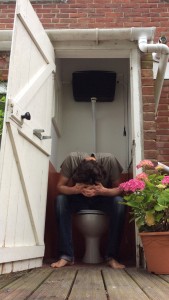 My prejudice against the so-called water-efficient toilets was seeded about two years ago when we moved from a one-lavatory house to a three-lavatory house – yes, that meant one lavatory per occupant. The big surprise on moving in was that the small outhouse on the back of the building contained a functioning old-style high-cistern pull-chain siphon-flush toilet, with panoramic views of the garden. This WC remains a little-used curiosity, and the outhouse is mainly used for storage now (or for posing in – see the photo on the right).
My prejudice against the so-called water-efficient toilets was seeded about two years ago when we moved from a one-lavatory house to a three-lavatory house – yes, that meant one lavatory per occupant. The big surprise on moving in was that the small outhouse on the back of the building contained a functioning old-style high-cistern pull-chain siphon-flush toilet, with panoramic views of the garden. This WC remains a little-used curiosity, and the outhouse is mainly used for storage now (or for posing in – see the photo on the right).
However, inside the house the other two lavatories were identical modern drop-valve dual-flush models, and both of them had the same problem: they leaked. It wasn’t really something that I noticed during the busy-ness of the moving-in process, but when I was lying in my new bedroom at night I could definitely hear the slow plink-plink-plink of dripping into the toilet bowl coming from both the upstairs and downstairs toilets. At frequent intervals this was drowned out by the sound of the partially drained cistern re-filling. Best of all the downstairs toilet featured a small sticker that said ‘Leak tested’ to which the previous tenant had added (in biro) NOT!
At what was a particularly stressful time of my life, the problem of the toilets that needed attention seemed significant and insurmountable. Of course eventually I just got to it and googled the problem, wrestled with the contents of the cisterns to determine what needed doing, ordered the replacement parts online and then spent even longer wrestling with the flush mechanisms to fix them. And through it all the thought was in my head: “These new style dual flush toilets are crap. The old siphon toilets never had this problem. I hate dual-flush toilets.”
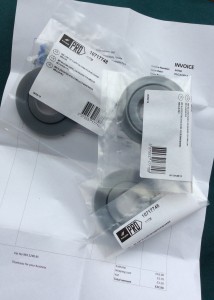 That wasn’t the end of it though. When we moved in we were told by the letting agent that the house was not on a water meter – ‘Great!‘ I thought, ‘it won’t cost us if the toilets keep leaking‘. That turned out to be wrong, a letter arrived from the water company telling us that we did in fact have a water meter. Not long after that the flush mechanism in the upstairs toilet malfunctioned and I replaced it. A few months later the dripping began again and, much more quickly this time, I ordered the new washers and sorted it out. And this pattern has repeated, the toilets requiring regular minor maintenance leaving me wondering if I could bulk-order the replacement washers (see the photo on the right).
That wasn’t the end of it though. When we moved in we were told by the letting agent that the house was not on a water meter – ‘Great!‘ I thought, ‘it won’t cost us if the toilets keep leaking‘. That turned out to be wrong, a letter arrived from the water company telling us that we did in fact have a water meter. Not long after that the flush mechanism in the upstairs toilet malfunctioned and I replaced it. A few months later the dripping began again and, much more quickly this time, I ordered the new washers and sorted it out. And this pattern has repeated, the toilets requiring regular minor maintenance leaving me wondering if I could bulk-order the replacement washers (see the photo on the right).
So, when this week I saw the headline in the paper I felt a sense of ‘I told you so!’ The dual-flush toilets are a false water economy! We were better off with the old siphon mechanisms! The only person nearby to tell was my son, but he didn’t care… and so this blog post started to take shape in my mind. It started with recognising the rush that accompanies Being Right (confirmation bias: I wouldn’t have paid the article much attention if I didn’t already think that dual-flush toilets were a false economy), was fed by the desire to explain the mechanics of toilet flush mechanisms (remember, I’m a physics teacher too) but ended up with me considering the complicated tangle of trying to make a difference for the better in the world.
Now that I’ve declared my interest (or prejudice) I can outline the shape of the rest of this article. In it I describe the difference between the old and new toilet flush technologies, with particular reference to their advantages and disadvantages with regards to water efficiency. I then discuss the context in which the old technology was superseded by the new, and why this supposed change for the better may have turned out to be a colossal mistake. I finish by considering where the toilet water-efficiency problem may go from here – what are the possible solutions, what are the ideologies within which the solutions will be conceived, and who is responsible for sorting this problem out?
In this article I will be assuming that improving water efficiency (by reducing wastage and demand) is a desirable thing: that it is morally good. I won’t be providing much justification for this, suffice to say that water is a renewable but finite resource and that here in the UK (where fresh water is rather abundant) we devote a lot of other finite and non-renewable resources to treating water for mains supply. I am also assuming that it is worthwhile to attempt to improve water efficiency by specifically focussing on the issue of flushing toilets – it may be in practice that any savings there are insignificant in comparison to other wastage in the system (for example, leaking supply pipes), and I’ve not investigated the figures for comparison. I do not suggest non-WC alternatives such as composting and ‘wild weeing’.
Right… are you sitting comfortably? Then I’ll begin…
Toilet technology
It is not completely impossible for a traditional toilet to leak, but due to their design they are very unlikely to leak. In a traditional toilet the water in the cistern must first flow upwards before it can flow downwards into the toilet bowl. Water will not flow uphill without assistance (as I’m sure you’re aware!) and your push on the handle provides the necessary lift to get the flush going. Once the flow has started the water will continue to siphon out until the cistern is empty.
This explains why siphon-based flush mechanisms are considered to be wasteful of water – every flush completely drains the cistern, whether or not that much water is actually needed to do the job. It also explains why they are so robust against developing a leak into the toilet bowl, simply because water cannot travel uphill unaided. On the rare occasions when I’ve experienced these toilets leaking it was down to a fault in the re-filling mechanism, and the dripping was from the overflow pipe on the outside of the building.
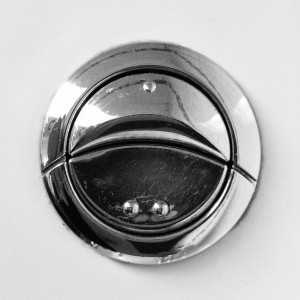 In order to achieve variable-volume flushing the designers of modern ‘dual flush’ toilets have done away with the cistern-emptying siphon mechanism. Instead, in the common ‘drop valve’ design, when the flush buttons are pressed a plug is yanked out of a plughole in the bottom of the cistern and the water drains down into the toilet bowl. One of the flush buttons yanks the plug a long way out of the plug hole, so that the entire cistern drains before it falls back in to seal it up again. However, the other flush button only yanks the plug out a little way, and it drops back in when only a fraction of the water in the cistern has escaped.
In order to achieve variable-volume flushing the designers of modern ‘dual flush’ toilets have done away with the cistern-emptying siphon mechanism. Instead, in the common ‘drop valve’ design, when the flush buttons are pressed a plug is yanked out of a plughole in the bottom of the cistern and the water drains down into the toilet bowl. One of the flush buttons yanks the plug a long way out of the plug hole, so that the entire cistern drains before it falls back in to seal it up again. However, the other flush button only yanks the plug out a little way, and it drops back in when only a fraction of the water in the cistern has escaped.
The dual-flush design has the flexibility for toilet-users to choose to use an amount of water that is appropriate to the job. However, in order for the water to remain in the cistern between flushes the fit of the plug into the plughole must be perfect – if there is the slightest imperfection in this seal then the pressure from the water in the cistern will force water to leak down into the toilet bowl. Under the real-life conditions of bargain-basement manufacturing, inexpert installation and frequent flushing the flush valves rarely work perfectly for long, and as a consequence millions of litres of treated fresh water quietly leak uselessly through the toilet when it isn’t in use.
Lavatory legislation
The leak-proof design of the traditional toilet siphon was the primary reason why they were the only legally permitted style of lavatory design in the UK. However, in the early 1990s – against a backdrop of water industry privatisation, greater awareness of environmental issues and a spate of hotter, drier summers – public concern about water efficiency grew. Simple measures to reduce flush volumes were suggested, such as putting a brick into one’s toilet cistern, but this approach was limited by the fact that the siphon mechanism allowed a relatively low flow rate and so a large volumes of water was needed for a flush to shift solids into the sewers.
The law was changed in 2001 to allow non-siphon lavatories to be installed in the UK. To politicians in the late 1990s this must have seemed like a ‘no-brainer’. The dual-flush design promised huge improvements in water efficiency: they had a higher flow rate than siphon toilets, so less water was needed to shift solids from the bowl, and they also gave toilet users an obvious option of using a shorter flush when they were disposing of urine. Toilet users were able to feel environmentally virtuous every time they opted for the short flush – which would be many times per day – and it’s not like they were doing it in order to save money, as few households at the time were on a water meter.
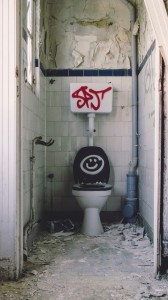 So 16 years later, and the traditional siphon flush lavatory is an endangered beast. The dual-flush design is now far more popular, having been the installation of choice in new-builds since 2001. This is a long enough time for the drawbacks of this new technology to become apparent, and for not-for-profit bodies like Waterwise to investigate and report on the false economy of switching from siphon flushers to valve mechanisms. It makes for a satisfyingly ironic headline in the news: “So-called water-efficient toilets leak millions of litres every day”, but perhaps it is better seen as a cautionary tale about the unintended consequences of introducing what seemed like common-sense changes.
So 16 years later, and the traditional siphon flush lavatory is an endangered beast. The dual-flush design is now far more popular, having been the installation of choice in new-builds since 2001. This is a long enough time for the drawbacks of this new technology to become apparent, and for not-for-profit bodies like Waterwise to investigate and report on the false economy of switching from siphon flushers to valve mechanisms. It makes for a satisfyingly ironic headline in the news: “So-called water-efficient toilets leak millions of litres every day”, but perhaps it is better seen as a cautionary tale about the unintended consequences of introducing what seemed like common-sense changes.
To use a particularly inappropriate metaphor, it seems as if the baby was thrown out with the bathwater in the aftermath of the change of legislation in 2001. In the name of ‘water efficiency’ leak-less siphon toilets have been displaced by the leak-prone dual-flush toilets. The problem is not insignificant: Waterwise claims that 4% of UK toilets leak from the cistern, and the average one leaks 215 litres a day. Total UK toilet leakage amounts to 400 million litres per day, which accounts for 5% of clean water consumption.
What went wrong?
So, were the benefits of the siphon flush mechanism under-rated when the changes to toilet legislation were being made in the late 1990s? The leak-proof design perhaps was not fully appreciated by those who had grown up with it in the background of their lives because it was just so good at invisibly and silently doing its primary job (from a water-efficiency perspective): not wastefully leaking water between flushes. The billions of litres of water per week that were not leaked by siphon toilets over the century or so of their prevalence could not be seen, or easily appreciated.
When dual-flush toilets were first introduced they made the siphon toilets look, by comparison, poor at performing their secondary job of flushing waste into the sewer using the minimum amount of water. The key thing to note here is that the major benefit of the siphon toilet was inobvious to toilet users, but the major drawback was completely obvious: in a more water-efficiency conscious time the toilet user potentially had to face up to their guilt about wasting water every time they flushed a siphon toilet. Switching to a dual-flush was a noticeable change for the better – the cisterns were significantly smaller, and one now had the ability to easily choose a short or long flush, appropriate to the occasion.
The problem that cancelled out the gains in water efficiency only became obvious once the change-over was well under way. Presumably the early models were of sufficiently high quality that their drop valves did maintain their integrity for the required 200 000 flushes under laboratory conditions. In real-life conditions though, the drop valve toilets did not perform as well. Poor installation of the toilet could result in leaks. Debris introduced to the cistern during installation could get stuck in the valve, resulting in leaks. In hard-water areas limescale could similarly affect the valve, resulting in leaks. And when the leaks happened at first they would have been very hard to spot, with the water quietly and continuously seeping into the toilet bowl.
Perhaps, most significantly, the nature of the free market in bathroom supplies meant that consumers would opt for the cheaper models – especially landlords of rented properties and businesses – and in the race to produce the cheapest flush mechanisms the quality of the early models was not maintained. In order to keep my own dual-flush toilets in leak-free order I have to replace the rubber washer on the drop valve every six months or so. That’s not a problem for me, but then I’ve got the money to buy the spare parts and the skills and confidence to do the maintenance myself – but I don’t think I’m particularly representative of a typical toilet-owner, and the old siphon toilets didn’t require such regular servicing.
Where do we go from here?
The conservative lament that “we should never have messed with it!” is not particularly helpful, and if rejection of innovation was absolutely applied we’d still be squatting in the bushes when nature called. “If it ain’t broke then don’t try to fix it” is a slightly more refined argument, but it is only with hindsight that the siphon toilet doesn’t appear to be broken. There is some wisdom in being aware of our tendency towards neophilia, the love of new things simply for the sake of their newness: expect it, and challenge it – especially when it is coupled with the desire to be seen to be doing something rather than nothing.
Another point to be taken from this story is it that it is wise to accept the results of laboratory testing provisionally, and with caution: lab testing is unlikely to reveal the flaws that become apparent when the technology is used in the messy, complex real world. This also reminds me of the precautionary principle: when a new technology is proposed then the burden of proof that the technology will not cause more harm than good is on those proposing the change to the status quo. Simple arguments (like ‘dual-flush toilets use less water than siphon toilets, therefore we ought to replace siphons with dual-flushers’) are usually deceptively simple, masking the complexity of the issue. Our desire for straightforwardness and certainty when making decisions means that we are reluctant to think critically about what is being proposed.
In trying to improve the water-efficiency situation there is the danger of adopting an absolute scientistic view: that the sustained use of science and its application (technology) will fix the problem. I’ve already mentioned above the problem with over-reliance on the results of laboratory testing, and another aspect of this is the belief that the technological problem will be solved only by more technology – better toilets, more efficient flushing mechanisms, the integration of computer processors, sensors and actuators into the lavatorial arena. In this way we can end up overlooking simpler, more obvious, more universally applicable solutions (remember the large proportion of humans that don’t have access to even the most basic toilet technology).
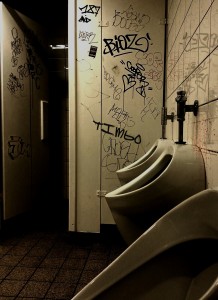 There are cultural factors at play here too, ones that are often difficult for us to appreciate because they are part of our own conditioning. One very simple innovation that greatly improves water-efficiency is the urinal, especially the waterless variety. However, when was the last time that you saw a urinal in a domestic setting? And, ladies, when was the last time you saw an (appropriately designed) urinal in a public lavatory? There are not really any material barriers to installing urinals in homes, or to widespread installation of female urinals in public toilets, so what’s stopping us? With the increased technology surrounding the business of urinating and defecating the subject has become closer to taboo in society – I don’t know how exaggerated the reports are, but consider the technological lengths employed in urban Japan to cover up the embarrassment that comes with the fact that humans need to urinate (musical toilets and so on).
There are cultural factors at play here too, ones that are often difficult for us to appreciate because they are part of our own conditioning. One very simple innovation that greatly improves water-efficiency is the urinal, especially the waterless variety. However, when was the last time that you saw a urinal in a domestic setting? And, ladies, when was the last time you saw an (appropriately designed) urinal in a public lavatory? There are not really any material barriers to installing urinals in homes, or to widespread installation of female urinals in public toilets, so what’s stopping us? With the increased technology surrounding the business of urinating and defecating the subject has become closer to taboo in society – I don’t know how exaggerated the reports are, but consider the technological lengths employed in urban Japan to cover up the embarrassment that comes with the fact that humans need to urinate (musical toilets and so on).
Finally, there is the question of responsibility: who will take responsibility for improving water efficiency? We have to be careful of polarising the issue here: it is not entirely the responsibility of the government, neither is it entirely the responsibility of individual toilet-users. The government has and can play a part: regulating the manufacture and installation of lavatory technology, and legislating for increased use of water metering by the (privatised!) water supply companies – metering and creative tariffs are a way of introducing a financial incentive for end-users to improve their water efficiency. Personal responsibility could be as simple as applying this lavatorial heuristic: “If it’s yellow, let it mellow. If it’s brown, flush it down.” Good luck discussing that with your co-habitants.
Further reading and resources
- ‘Water-efficient’ toilets leak millions of litres every day: web version of the Times article that provoked this piece. Note that most of the text is behind a paywall, and the headline in the print version differed (‘loos’ versus ‘toilets’).
- Conserving water in buildings: a practical guide (.pdf) A publication by the UK Environment Agency, published in 2007. Chapter 1 is the most relevant to this article.
- Change the world: save our toilets! by John-Paul Flintoff. A short documentary video (10 minutes) on youtube, dealing with the toilet-leakage issue.
- Waterwise – an independent, not for profit organisation, that receives funding from the UK water industry, sponsorship and research projects. In their own words: Waterwise “was founded in 2005 and has become the leading authority on water efficiency in the UK and Europe.”
Image credits
- Photograph of me sitting on the outhouse toilet: own work (c) Jim Champion
- Photographs of dual flush button and drop valve washers: own work, licence CC0 Public Domain
- Photograph of happy WC: downloaded from unsplash.com
- Photograph of urinals: licence CC0 Public Domain, downloaded from pixabay.com

Thanks for this great post, Jim! I think it’s the first we’ve had on the MWS site that could be described as being about engineering. But it seems entirely appropriate, because it’s as much a field for the application of the Middle Way as anything else. The idea that neophilia (or neomania) should be challenged and that older technologies may actually be more appropriate in many contexts is an important part of thinking in the area of sustainable development – where it used to be called ‘intermediate technology’ (I’m not sure how much that term is still used). That seems very much aligned with the Middle Way, in between the absolutizing extremes of Romantic Luddism and Neomanic technologism.
The most basic principle of intermediate technology seems to be to adopt the device that will do the job required with the minimum of technological complexity. This morning, for example, I bought a car tyre pump. I found that there was an array of them available, from very cheap foot pumps to complex electrical pumps that automatically inflate your tyre to a pre-set pressure. I was briefly tempted by one of the latter, before I reflected about the likelihood of it going wrong. I eventually opted for a foot pump that was slightly above the bottom of the range, on the grounds that it still used my energy and was a reasonably simple device, but might last longer than the cheapest one.
Thanks for the additional input Robert. Intermediate technology sounds like ‘good enough’ technology. Seems like it will be a struggle to promote adoption of this technology in an economy that is based on continuous growth though.
I’m currently reading ‘Adapt’ by Tim Harford. In the introduction he mentions Thomas Thwaite’s toaster project. It is quite an eye opener: https://www.ted.com/talks/thomas_thwaites_how_i_built_a_toaster_from_scratch/transcript?language=en
Technological fads are common in teaching too, as I’m sure you know too. One of the more expensive ones involved interactive whiteboards in classrooms. It became ridiculous, a game of keeping up with nearby schools (ooh don’t you know they’ve got IWBs in all their classrooms) and while schools each spent tens of thousands on them the companies selling them made a tidy profit. Look what actually happened though: as they inevitably malfunction or stop working completely, they’re being replaced by non-interactive whiteboards (I.e. a digital projector projecting onto a traditional wipe-clean whiteboard).
Something more specific to my subject specialism: dataloggers. Bought, as we thought we really needed them, then rarely used, for all sorts of reasons. Then, when technology had moved on a bit, a new datalogger system. Then another. Now a typical smartphone has more sensors, GPS, plus a high resolution video camera, and most of the students have one in their pocket.
Please no one bring up chalk blackboards. They are terrible compared to write-on whiteboards. It was a good thing when blackboards in schools became obsolete!
On the same theme…
This BBC documentary is excellent, but it isn’t currently on iPlayer:
http://www.bbc.co.uk/programmes/b01kxyhd